
- posted: Jan. 28, 2020
Diabetic Retinopathy
Uncontrolled diabetes can cause a serious condition of the eye called diabetic retinopathy. This condition causes damage to the blood vessels in the back of the retina. It can also cause abnormal blood vessels to form. Because this condition is very serious, it is essential that you schedule annual eye exams.
Who Is At Risk For Diabetic Retinopathy?
Anyone with diabetes can develop this condition. Certain factors can increase your risk of getting it. Some of these factors include:
- An increased risk the longer you have diabetes
- Poor control of your blood sugar levels
- High cholesterol
- High blood pressure
- Pregnancy
- Smoking
- African-American, Native American or Hispanic ethnicity
What Are the Symptoms Of Diabetic Retinopathy?
In the early stages, this condition often shows no symptoms. As the disease progresses, you can begin to experience the following:
- A dark spot or strings floating in your vision (Floaters)
- Blurry vision
- Vision fluctuations
- Impaired color vision
- Dark areas in your vision
- Permanent vision loss
How Is Diabetic Retinopathy Diagnosed?
Diabetic retinopathy can be diagnosed during your annual dilated eye exam. Dr. Boyle will put dilating drops in your eyes, expanding your pupils, allowing her to get a larger and better look into your eyes to check for the following:
- Abnormal blood vessels
- Growth of new blood vessels (neovascularization)
- Blood or swelling in the retina
- Bleeding in the vitreous
- Optic nerve abnormalities
- Retinal detachment
After the dilated exam, Dr. Boyle may want to perform an OCT to document or further investigate areas of concern. An OCT provides cross-sectional views of the retina, allowing Dr. Boyle to determine whether blood vessels in the retina are leaking and causing swelling to the retinal tissue.
How Is Diabetic Retinopathy Treated?
In the early stages, Dr. Boyle will monitor your eyes closely through eye exams every three to six months. If the diabetic retinopathy progresses, Dr. Boyle will refer you to an ophthalmologist for further treatment options including:
- Photocoagulation: This is a laser treatment that can stop or slow the leakage of blood and fluid in the eye. It is often done in the ophthalmologist’s office, and the blood vessels are treated with laser burns.
- Pan retinal photocoagulation (PRP): This is a laser treatment that can shrink the new blood vessels that have developed.
- Vitrectomy: This is a surgical procedure that is done under local or general anesthesia. During the procedure, the doctor will make a tiny incision in the eye to remove blood from the vitreous. They will also remove any scar tissue that is tugging on the retina.
- Injections of medication: Most recently, anti-VEGF (vascular endothelial growth factor inhibitor) injection therapy, used mainly for patients with macular degeneration, are being explored. These medications are injected into the eye, which may stop the growth of new blood vessels.
Diabetic Retinopathy Treatment in Saint James
If you have diabetes, it is essential that you receive annual eye exams. To schedule an appointment with Dr. Boyle, you can contact us directly through our website or call us today at (507) 375-2020.
Location
Hours of Operation
8:00 am - 5:30 pm
8:00 am - 5:30 pm
8:00 am - 5:30 pm
8:00 am - 5:30 pm
8:00 am - 5:30 pm
Closed
Closed

